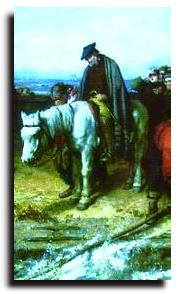Culloden

After Falkirk, Charles was all for turning south again but his officers advised moving north. Charles was aghast, but had to accept. His army grew smaller as they marched north through the Highlands and the Duke of Cumberland was again in pursuit with fresh troops. By 20 February Charles and fewer than 5,000 men reached Inverness. It took time for the government forces to assemble and reach the Moray Firth but gradually 8,000 men were advancing on Inverness. On 16 April 1746 the opposing forces met on Culloden Moor. Hanoverian cannon fire over a period of an hour killed many clansmen. When the Highlanders eventually charged, the rifle fire from the redcoats ripped into them. "Butcher" Cumberland had given the order that no quarter was to be spared and many wounded Jacobites were later killed. It is estimated that Jacobite losses amounted to 2,000; the Hanoverians lost 300.
The Aftermath
The government forces hunted down anyone who was thought to have participated in the "Jacobite Rebellion" and many houses and castles were torched. The only unit to show any compassion was the Campbell militia from Argyll. Hundreds were executed (after brief trials in England), 700 died in the prison ships in the river Thames in London and a thousand were sold as slaves to the American plantations. The kilt was banned and no Highlander could carry a weapon. The clan system may not have lasted for much longer anyway, but the aftermath of Culloden hastened its demise.
Flight Across the Heather
Prince Charles had to flee the battlefield. A huge reward of £30,000 for his capture was offered but over the next five months Charles was kept out of the hands of the Hanoverians by many brave people. By the end of April he had sailed to the Outer Hebrides, remaining there for two months. On occasions, his skill with the gun allowed him to keep himself and his companions in food. Towards the end of June, government forces were closing on him in Uist and Flora MacDonald was recruited to spirit him over the sea to Skye, disguised as her maid. The song "Over the Sea to Skye" commemorates that journey. They reached Portree a few days later and the Prince bade farewell to Flora on 1 July. Eventually, on 20 September, he embarked from Arisaig for France in a French ship which had been sent to collect him.
Charles' Later Years
When Bonnie Prince Charlie left Scotland he fully intended to raise more money and return with French soldiers to mount another campaign. He never did. He visited London in disguise in 1750 and met up again with Clementina Wilkinshaw. She later accompanied him to Paris. They parted in 1760.
His campaign in 1745 was against the wishes of his father, the Old Pretender and they never met again in the remaining twenty years of the life of James Francis Stuart.
In 1772, at the age of 52, Charles married Princess Louise of Stolberg who was aged 20. In 1780, she fled from his excessive drinking and the beatings which he inflicted on her. She was later welcomed at the court of King George III in London. In his last few years, Charles was looked after by Charlotte Wilkinshaw, his daughter by Clementina. He died in Rome in her arms on 31 January 1788 and was buried at a church in Frascatti.



